#confederate statuary
Explore tagged Tumblr posts
Text
GPB News: Civil rights groups condemn 'Soul Fest' concerts at Georgia park with giant Confederate carving
Civil rights groups are criticizing a concert series with Black performers dubbed "Soul Fest" that is being held at a Georgia park replete with Confederate imagery, including a giant carving of Confederate leaders.
Stone Mountain Park just outside Atlanta is where the Ku Klux Klan marked its rebirth in 1915. Its colossal, mountainside sculpture of Gen. Robert E. Lee, Confederate President Jefferson Davis and Gen. Thomas J. "Stonewall" Jackson is the largest Confederate monument ever crafted and has special protection enshrined in Georgia law.
The park has taken steps in recent years to try to soften its Confederate legacy and promote itself as a family site, but civil rights groups have said the moves fall way short of what's needed.
The "Soul Fest" concert series is a way to "normalize and sanitize" the hateful message of the park, said Atlanta NAACP President Richard Rose.
"They're saying, 'This is OK. Get used to it. It's cool,'" he said in a phone interview on Thursday.
Rose said he encouraged two of the bands to pull out of the event, but they told him they were under contract, and their music brings people together.
"The music can't bring people together in front of this icon of the Confederacy," he said.
Emails to the park and its management company, Thrive Attractions, were not immediately returned. In a news release earlier this month, the park promoted Soul Fest as a new event that would allow families to experience a "full day of fun." An ad for the event on the park's website featured a photo of a smiling Black man and Black woman on a lawn.
The event, which runs from Thursday night through Sunday night, features rhythm and blues groups, a gospel singer and a Prince cover band.
It's a "bad faith effort" to distance the park from the Confederacy, said Rivka Maizlish, a researcher with the Southern Poverty Law Center.
"It's an effort to pretend that the park is for everyone while still maintaining this massive symbol of white supremacy," she said. Some supporters of the carving say it is a tribute to their ancestors who fought in the Civil War, not a celebration of white power.
The park 15 miles (25 kilometers) northeast of downtown Atlanta attracts large numbers of tourists and other visitors interested in hiking to the top of the mountain, walking the grounds or seeing a light show. In 2021, the park's board voted to relocate Confederate flags from a busy walking trail and create a museum exhibit that relates the history of the site and the carving, which was completed in 1972 amid resistance to the civil rights movement and desegregation by Georgia and other Southern states.
The changes approved by the board came amid a national reckoning on race that brought down dozens of Confederate monuments in 2020.
The park, however, still maintains the giant carving, which measures 190 feet (58 meters) across and 90 feet (27 meters) tall. The Soul Fest concerts will take place on a lawn that faces the monument just months after a Confederate group gathered there.
"It's just so beyond obnoxious and disgusting and gross that they're hosting these artists now and trying to pull in a different audience," said Brian Morris, a member of the Stone Mountain Action Coalition, an advocacy group that has called on the park to stop maintaining the carving.
#Soulfest#Atlanta#Stone Mountain#confederate statuary#national park#confederate statues#kkk#civil rights#Civil rights groups condemn 'Soul Fest' concerts at Georgia park with giant Confederate carving#white supremacy
7 notes
·
View notes
Text








One commentator proposed that Michelle had been stolen for scrap. Another postulated that she had been removed because she was deemed offensive (perhaps because her clothing is rather revealing), or she'd been taken off display for renovation. Another lamely attempted to equate her disappearance with the removal of the city's Confederate statuary a few years back.


Perret, who is now retired, said that in 1983 he sculpted a seated 19-century woman titled "Martha" at the behest of the Friends of the Market organization. Martha's basket of fruit was meant to imply that she'd been shopping at the nearby French Market. The ghostly statue was so popular with passersby that Perret was commissioned to produce another figure to sit at the edge of a fountain.
Perret said he called her Michelle after his daughter, though his daughter did not pose for the sculpture.
Perret said he's not surprised at all at the consternation over Michelle's disappearance. "It's my claim to fame," he said. "I got a tremendous amount of feedback." People, he said, sent him pictures "all the time."
Michelle isn't the first of Perret's sculptures to go missing. In addition to Martha and Michelle, the sculptor created a bronze still life featuring a tray of coffee and beignets, which was installed near Café du Monde in 1986. The small sculpture was stolen, replaced, and stolen again, Perret said. Still, when he learned in a digital discussion on Reddit that Michelle had gone missing, he was nonplussed. "I thought, 'What could have happened to it?' Perret said. "If you stole it, what could you do with it?"
But Michelle hadn't been stolen. And, despite the coincidence of timing, her disappearance had nothing to do with the recent hurricane either.
Instead, she'd fallen victim to another hazard of life in New Orleans. As a respondent to Campanella's original tweet revealed, she'd been vandalized. A miscreant had brushed her eyes and neck with paint.
"We removed her about a week before Ida," reported a city spokesperson, when asked about the disappearance. "She is safely tucked away in our maintenance shed. We are working on getting the paint off without removing the wonderful patina."
The city didn't give a timetable for when Michelle will be returned to her perch by the fountain.
2 notes
·
View notes
Text
Here’s a story a friend and I collaborated on. Credit goes to my buddy Downbelow82 on Coiledfist.
This was set in an idea I was exploring at the time, where the Civil War is won thanks to Southern giants, and this is set shortly thereafter. Fellow history buffs will notice some famous names: Eiffel is known for his Eiffel Tower, while Bartholdi was the designer of the Statue of Liberty. I loved that ironic touch. Also loved the “tour of devotion” idea for Yankees. And, of course, the cocky country boy Confederate soldier titans!
Anyway, hope y’all like it as much as I did.
-
While it had only been a few years since the war had officially ended, the monuments to the honored, victorious confederates sprouted up and down the Eastern seaboard. While there was no shortage of statuary in the heart of the South itself, usually constructed by an army of enslaved, the Confederate High Commission on Battle Monuments paid especial attention on the construction of monuments in the “Occupied North.” While the monuments in the South were sizable in their own right, the statuary constructed in the captured northern cities, or rather the remains of these cities, from Philadelphia to Boston, were to be mammoth in size.
These massive leviathan structures would rival nothing since ancient times when the Colossus strode the harbor at Rhodes. Much of Washington, the jewel of the former Federal union, was cleared away for the construction of a veritable Valhalla to the honored victorious Army of the South, vast monuments and temples on what used to be the capital city. The construction there continues. From the day of victory to the present day, wage slave laborers and outright slaves work round the clock to bring this sacred sight to fruition.
However, other cities were not without their honored places. In Philadelphia, for example, in the “Night of the Reb’ Purge” as the locals called it, behind closed doors, much of the cities famous sites of Revolutionary fame were destroyed.
At Independence Hall, where that famed document cementing North America’s divorce from the British Empire was signed, all that remained was an empty lot. The old Georgian hall had suffered at the wanton destruction and mercy of the Confederate Super Soldiers and their Giant Legion. While the mass of bricks, timber, and other ruin were carefully excavated from the sight, the massive bootprints of the giant soldiers were purposely left behind, a stark reminder of the power of the Arisen South and their superior military might.
While the massive indentations were left as is, with just the ruins moved out, one exception was made. In one particularly massive boot print were the crushed remains of the once famed Liberty Bell, which was tolled in a fateful July some 4 score and seventy years earlier, as an ex Northern politician once notably put to words. The new masses of second class citizens were made to visit, from separate viewing platforms than the ones used for tourists from the South. The honored Southern tourists watch in amusement as these lower citizens and chattel were made to literally bow before this now deemed “sacred” sight. The way a pilgrim would bow in Lourdes or Mecca, the newly incorporated citizenry would be made to bow with great reverence at the boot print and crushed bell. Before their “tour” was complete, a kiss was required on the banner of Confederate Battle Flag (to which they would also bow, the Battle Flag now a sacred symbol across the nation) and the Stars and Bars. Once done three times in each month, their monthly “service of devotion” was completed, as mandated by law.
Not far from the former site of Independence Hall was a specially constructed, Athenian inspired temple, housing more sacred relics. A pair of massive boots of one of the honored veterans of the Battle of Philadelphia were put on permanent display. The leather of the huge boots, particularly on the tongue area, was faded pale from the hundreds of hands touched upon in daily, rubbing for good luck and reverence. A huge battle flag was proudly on display, to which Northerners bowed and Southerners proudly saluted.
This was all well and good but was not satisfactory enough for the Battle Monuments Commission or the government in the burgeoning metropole of New Richmond. No, something much more groundbreaking would be constructed in the backdrop of the ruins of Independence Hall. While Europe was still in turmoil over the events in North America, maintaining a very uneasy neutrality, a flurry of entrepreneurs flooded into the Confederacy for a chance at opportunity and the age old pursuit of lucre. This included many great European architects and sculptors. A noted many, including a civil engineer named Eiffel and a sculptor named Bartholdi were encouraged to emigrate by the government in New Richmond.
The project in Philadelphia, like many monuments across the great nation, would commemorate the Giant Soldiers of that great war. It would take months of back breaking labor, resulting in the deaths of numerous workers, but an amazing structure would emerge to tower over Philadel,’ nearly 300 feet in height. An ingenious skeletal structure was surrounded by sheets of hammered copper. It was a glorious site to behold as it neared completion. A 300 foot tall recreation of a Confederate soldier, complete with an immensely handsome young face and musculature not so subtly covered beneath his gray battle uniform. In his massive right fist was a towering flagpole, with the Stars and Bars raised and proudly flowing mid air. His left arm held tightly his trusty rifle that had slaughtered easily so many yanks. His even more trusty weapons, his left boot and right boot made their own respective statements.
The massive right boot was frozen in a pivot, grinding a marble sculpture of the old constitution of the Defeated Federal Tyranny. Under the massive left boot, a recreation of the old White House that once sat proudly in Washington City, was in the midst of being crushed by the weight of the powerful young soldier. While the old Republican minded Frenchman, Bartholdi and Eiffel were a bit uncomfortable at the subject matter of this construction, they realized this was the new way of things and were grateful for the work. All effort was put into making the statue a work of perfection and immaculate engineering and structural integrity.
With just one day before the officially planned opening and unveiling ceremonies, an impromptu visit by certain “authorities” was made known to the builders with virtually no time to prepare. The visitors were dispatched from the Confederate Base on the Delaware River, Fort Davis. The occupied cities were no strangers to the giant soldiers who continued to patrol their streets and wreak havoc..or rather, law and order as they saw fit. Philadelphia was no exception.
By noon, the ground began to tremble with a sinister rhythm. A shadow soon cast over the building site. Thousands of laborers froze in place as the team of behemoth white soldiers approached. They were young, between the ages of 18 and 20, and were sent by the Base commander as a show of arrogance. Their huge grey uniforms fluttered in the gust of wind that blew in from the riverside. The bills of their peaked caps kept the upper portions of their faces in shadow, leaving only their smirking mouths visible to the bug sized people below. Finally, the oldest soldier in command, a 20 year old LT stepped forward, his massive boot obliterating a horse and carriage that was unfortunate to be in his path. The god sized soldier spoke, his sexy Southern twang unmistakable.
“WELL…WELL…WELL. WHAT HAVE WE HERE, BOYS? LOOKS LIKE THE CITIZENS HAVE CONSTRUCTED A LIL SOMETHING IN OUR HONOR. WELL, HO-LY SHEE-IT. LOOKS PRETTY DAMN GOOD.”
The men grumbled and laughed.
The foreman cautiously approached the soldiers face, from high atop the wooden scaffolding surrounding the statue. At least a hundred other workers remained frozen in place atop that same scaffold.
‘Please….Monsiuer…we ‘ave labored very very hard…with this great construction….umm…for the honor of your um…les militaires…your giant soldat, Sir.”
The soldier giggled at the heavy accent of the foreman.
“GODDAMN, BOY. YOU SPEAKIN’ WITH MOLASSES IN YOUR MOUTH…YOU NEED TO LEARN SOME ENGLISH NICE AND PROPER, YA HEAR? THAT GOES FOR ALL Y’ALL. THIS IS CONFEDERATE AMERICA, RUNTS. WE FUCKING SPEAK ENGLISH HERE!”
The forman cowered.
“Oui!…Oui, Sir. D’accord!”
“WELL, BOYS…WHAT DO YA THINK?”
The giant young men mumbled to each other.
One Private spoke up.
“LOOKS GOOD, SIR….BUT NEEDS A SLIGHT…”ADJUSTMENT.”
The Private winked, and the other soldiers laughed in agreement.
“WHY, PRIVATE, I DO BELIEVE YOU ARE RIGHT. IT IS DAMN PERFECT. A TRUE REPRESENTATION OF OUR MIGHT…BUT IT DOES INDEED NEED A LIL ADJUSTMENT.”
The LT pointed to the Stars and Bars and a private approached and carefully removed the flag with great respect and care.
“GOOD…DON’T WANNA BE MUSSIN’ UP OUR SACRED FLAG…..NOW…WHERE WAS I….”
The soldier approached the statue, and the scaffold, with absolute disregard and care for the men atop it. His massive muscled arms extended out, crashing into the wooden structure, in order to grapple the statue underneath. The tiny men screamed out in terror and pain as they were crushed or flung to the ground below, the fall killing most. Some, broken and bloodied, were crushed under the soldier’s shifting boots.
The foreman cried out with one last plea.
“Mon Dieu….please!! Do not do is! This is for you, my Lords…why? Why??”
The soldier gave a quick glance and with a flick of his thumb and forefinger, the tiny frenchman was brutally flicked away, his broken dead body landing in one of the nearby Independence Hall boot prints.
The soldier has successfully wrapped around his bulging arms around the statue and began to lift. The accompanying giant young men began to shout their infamous rebel yells as the statue crumbled and separated from its base. The manly grunts could be heard for miles around. The LT smirked so broadly, his pearly white teeth glistened in the sun.
With a few steps, he stood over the remaining laborers and callously dropped the statue. In an instant, a hundred men were crushed or trapped under the iron work and copper. The soldier dusted off his hands and spoke to all around that were still clinging to life.
“IT’S GOOD….A DAMN GOOD STATUE…BUT IT AIN’T FUCKING GOOD ENOUGH…START OVER. BIGGER. BETTER.”
More rebel yells erupted as the soldiers slapped each other on the back and slowly stomped off, crushing as many fleeing Yanks as they could. It was their prerogative to do so and nobody would stomp them. Some, in desperation, ran over to the sacred boot prints and in a religious fervor bowed and prayed for forgiveness from their Southern Gods.
19 notes
·
View notes
Text
Atlanta removing ‘Lion of the Confederacy’ statue from historic Oakland Cemetery
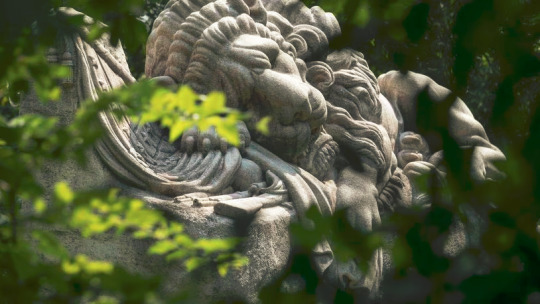
The city of Atlanta is set to remove a 127-year-old Confederate monument from Oakland Cemetery after it has repeatedly attracted vandals wielding sledgehammers and spray paint cans.
The City Council passed a resolution Monday evening declaring that the city should remove the “Lion of the Confederacy” monument and place it in temporary storage. The removal could happen as soon as this week, according to a member of City Council.
In recent years the statue has been defaced with graffiti, red latex and hit with objects like a pickaxe and sledgehammer.

The statue was built by T.M. Brady and dedicated on Confederate Memorial Day in 1894 to honor the 3,000 unknown Confederate dead resting in Oakland Cemetery. The statue depicts a wounded or dead lion with its right paw resting on a cannonball partially concealed by Confederate flag.
The lion’s removal follows years of discussion among city leaders about how to address contentious Confederate iconography in Atlanta. In 2017, then-mayor Kasim Reed signed off on a 40-page report written by an 11-member panel that included recommendations related to Confederate symbols in the city.ExplorePhotos: Confederate memorials in metro Atlanta
Among the recommendations was the renaming of Confederate Avenue in the Grant Park and Ormewood Park neighborhoods to United Avenue, and attaching contextual markers to monuments like the Lion of the Confederacy and a 65-foot-tall Confederate obelisk also located inside Oakland Cemetery.
What sets both objects apart from Confederate monuments that sit in front of courthouses, state capitols or on city streets is that they are not “in your face,” but are part of the statuary of the cemetery, said Sheffield Hale, president and CEO of the Atlanta History Center.
Carved from Georgia marble, the lion is modeled after the Lion of Lucerne in Lucerne, Switzerland — an 1821 sculpture memorializing the Swiss guards massacred during the French revolution. The 30-foot-long Swiss sculpture is carved into the face of a low cliff, and is considerably larger than the Oakland version.
Atlanta City Council member Carla Smith, a sponsor of the legislation to remove the lion, led the panel established by Reed and was a major force behind the contextual markers.
While the committee never recommended the removal of the lion, vandals have left the city little choice but to move it to an undisclosed location, Smith said.

“They’ve smashed the face, the nose is completely missing and the cost of trying restore it is becoming too much,” Smith said.
“There’s been this constant vandalism and constant drain on city resources trying to protect and restore it,” said Councilwoman Natalyn Archibong, whose district includes Oakland Cemetery.
Richard Harker, executive director of the Historic Oakland Foundation, said that since October 2019, the marker had been vandalized at least eight times and that the interpretive signage below the statue, including the contextual marker, had been defaced repeatedly, sometimes in broad daylight. City employees have spent 150 hours rehabbing the statue after instances of vandalism.
Harker said six permanent security cameras had recently been installed in the park, including a couple aimed directly at the lion. Extra security guards had been hired in the last several months to deter vandals.
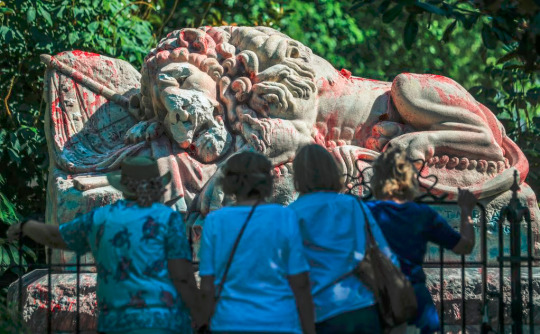
“The city’s history is good, bad, ugly and beautiful, and the city has to wrestle with all those legacies so we can move forward,” Harker said. “This is another example of the city, in a sad, unfortunate way, of doing so.”
The City Council approved a $33,000 contract with Superior Rigging and Erecting Co. to remove the lion statue. The city has not said where it will be located long-term.
The Confederate statue is listed by the Smithsonian as a historically significant piece of funerary art, Hale said, but removing it is a matter of public safety as well as preservation.
Hale also mentioned that the tension associated with the sculpture could lead to violence “adjacent” to the statue.
In the years since the city’s report on Confederate iconography came out, local governments around the state and nation have taken steps to remove monuments that glorify the Confederacy amid widespread protests against racism. The Georgia state law that makes it difficult for local governments to relocate or remove Confederate monuments was also updated in 2019 to include language that allows for “appropriate measures for the preservation, protection and interpretation” of monuments.
The Confederate obelisk in downtown Decatur came down last June. A Confederate monument built in 1993 in Lawrenceville’s downtown square was removed earlier this year.
#Atlanta to remove ‘Lion of the Confederacy’ statue from Oakland Cemetery#lion of the confederacy#atlanta#confederacy#confederate monuments
5 notes
·
View notes
Photo
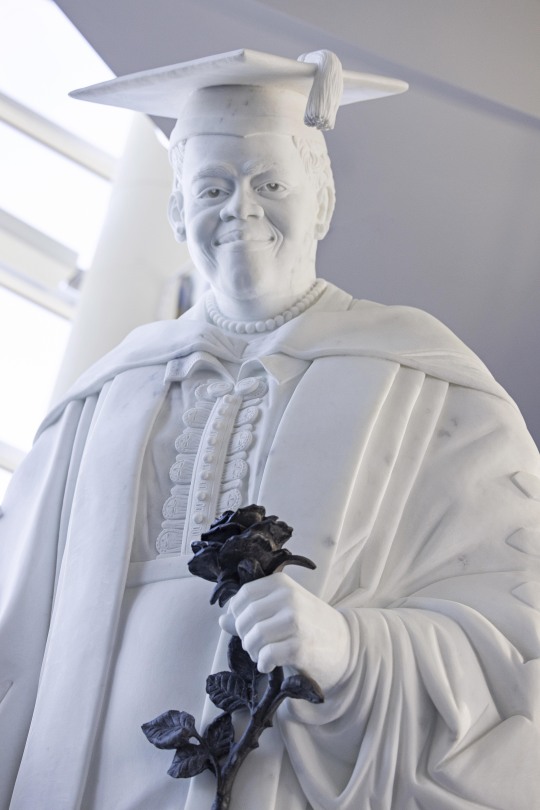


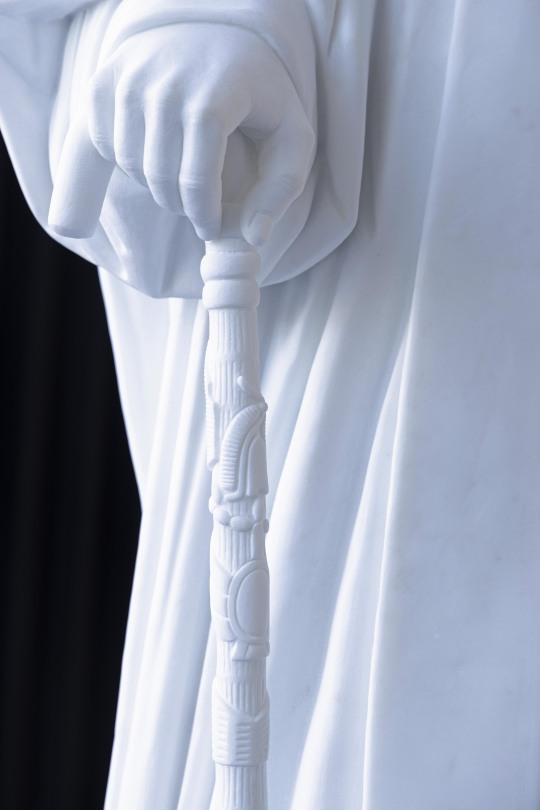



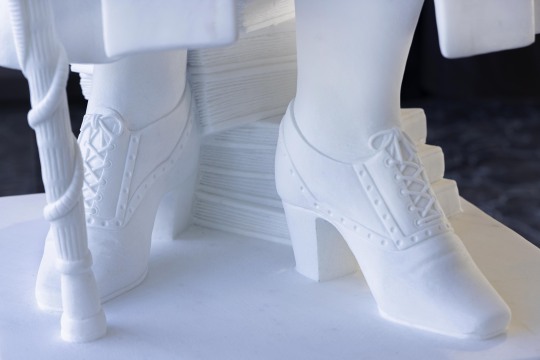

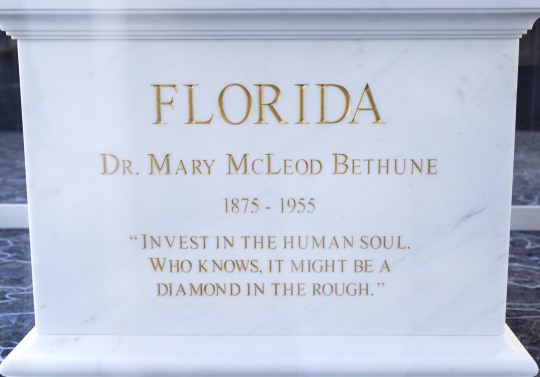
Dr. Mary McLeod Bethune Statue in Florida
A few months ago, I had the opportunity to photograph the larger-than-life marble statue of civil rights pioneer, presidential advisor and renowned Black educator, Dr. Mary McLeod Bethune, at the News-Journal Center in Daytona Beach, FL before it was being transferred to the National Statuary Hall at the U.S. Capitol. As the first state-commissioned statue of an African American, this project was led by University of Florida alum Bob Lloyd and sculpted by artist Nilda Comas, the first artist of Puerto Rican descent commissioned to sculpt a statue for the National Statuary Hall Collection.
The statue is made of Italian Carrara marble and carved by Comas in Pietrasanta, Italy. The combined statue and pedestal are 11 feet tall and weigh 6,129 pounds. Comas depicts an imposing, mature Bethune looking slightly downward, as though at a child. Her benevolent smile conveys her determined yet gentle demeanor. She holds a walking stick in her right hand and a black marble rose in her left, and she wears academic garb, including a mortarboard cap and tassel and a long robe. A dress with embroidered collar and lace details and a simple pearl necklace are visible below the open robe. Her shoes, with laces and sturdy heels, evoke pairs she wore when photographed in similar attire.
Dr. Mary McLeod Bethune was the founder of Bethune-Cookman College, Florida’s first institution of higher education for African Americans. Dr. Bethune’s statue replaced the statue of Confederate General Edmund Kirby Smith in the Capitol’s Statuary Hall.
#mary mcleod bethune#statue#bethune cookman college#florida#daytona beach#marymcleodbethune#bethunecookmanuniversity#ufalumni#boblloyd#adayeinthelife#national statuary hall#us capitol#bcc#national statuary hall collection#nildacomas#italian carrara marble#marble#educator#civilrights#comas#carrara marble
5 notes
·
View notes
Text
GOP rep wants ‘Elvis or nothing’ if Mississippi removes Confederate statues from Washington
(Bullshite. – DD) Help Dixie Defeat Big-Tech Censorship! Spread the Word! Like, Share, Re-Post, and Subscribe! There’s a lot more to see at our main page, Dixie Drudge! Each state is allowed two statues inside the National Statuary Hall’s collection with other Southern states such as Florida and Virginia approving measures in recent years to replace Confederate statues (Source) – Weeks after the…

View On WordPress
0 notes
Text
The Week in Confederate Heritage
The statue of Confederate president Jefferson Davis stands in National Statuary Hall on Wednesday, June 30, 2021. (Photo by Bill Clark/CQ Roll Call via AP Images) Credit: AP We begin this week with this article from Mississippi. “State lawmakers recently filed legislation to replace Mississippi’s two statues of white supremacists in the U.S. Capitol in Washington — a move that would follow the…

View On WordPress
0 notes
Text

Justices of the U.S. Supreme Court, Sandra Day O'Connor and Ruth Bader Ginsburg pose for a portrait in Statuary Hall surrounded by statues of men at the U.S. Capitol, March 28, 2001, David Hume Kennerly via Getty Images
Sandra Day O’Connor and Ruth Bader Ginsburg Changed the Supreme Court, and the Country
Despite their differences, the first and second female Supreme Court justices found common ground on women’s equality.
— July 30, 2021 | Linda Hirshman
By the time the nation celebrates the birth of its democracy each Fourth of July, the nine justices of the Supreme Court have mostly left town. But before departing the capital for their summer recess, they must first decide all the cases they have heard since their current term began the previous October. The hardest, most controversial cases, where the unelected Court orders the society to change in a big way, are often left to the end. As the days for decision tick away in late June, the tension in the courtroom is as hot and heavy as the Washington summer air.
On the morning of June 26, 1996, Justice Ruth Bader Ginsburg, the second woman appointed to the high court since its founding, slipped through the red velvet curtain behind the bench and took her seat at the end. Five places along the majestic curve sat Justice Sandra Day O’Connor, since 1981 the first woman on the Supreme Court, or the FWOTSC as she slyly called herself. Each woman justice sported an ornamental white collar on her somber black robe, but otherwise there was no obvious link between the First and Second, any more than between any of the other justices. On that day, however, the public got a rare glimpse at the ties that bound the two most powerful women in the land.
Speaking from the depths of the high-backed chair that towered over her tiny frame, Justice Ginsburg delivered the decision of the Court in United States v. Virginia. From that morning in June 1996, Virginia’s state-run Virginia Military Institute, which had trained young men since before the Civil War, would have to take females into its ranks. The Constitution of the United States, which required the equal protection of the laws for all persons, including women, demanded it.
Women in the barracks at VMI. Women rolling in the mud during the traditional hazing, women with cropped heads and stiff gray uniforms looking uncannily like the Confederate soldiers VMI had sent to the Civil War a century before. Six of Ginsburg’s “brethren” on the Court agreed with her that VMI had to admit women, but the case was much more contentious—and momentous—than that robust majority of seven reflects. Until that day, VMI had been the shining symbol of a world divided between men’s and women’s proper roles. Before the case got to the Supremes, the lower federal courts had supported VMI’s sex-segregated ways. For years, opponents of feminism used the prospect of women in military settings as the prime example of how ridiculous the world would become if women were truly treated as equal to men. VMI was one of the last redoubts. And now Justice Ginsburg, who, years ago as Lawyer Ginsburg, had been the premier advocate for women’s equality—the “Thurgood Marshall of the women’s movement”—was going to order the nation to live in that brave new sex-equal world.

Cadets marching at the Virginia Military Institute in Lexington, Virginia. Photographs in the Carol M. Highsmith Archive, Library of Congress
Few people listening knew that Ginsburg got to speak for the Court that morning, because her sister in law, O’Connor, had decided she should. After the justices voted to admit women to VMI at their regular conference, the most senior member of the majority had the right to assign the opinion to any justice who agreed. He assigned it to the senior woman, Sandra Day O’Connor, but she would not take it. She knew who had labored as a Supreme Court lawyer at the American Civil Liberties Union from 1970 to 1980 to get the Court to call women equal. And now the job was done. “This should be Ruth’s,” she said.
On decision day, justices do not read their whole opinions, which can often run to scores of pages. That morning, Ginsburg chose to include in her summary reading a reference to Justice O’Connor’s 1982 opinion in Hogan v. Mississippi, which had prohibited Mississippi from segregating the sexes in the state’s public nursing schools. O’Connor’s opinion for the closely divided court in Hogan, Ginsburg reminded the listeners, had laid down the rule that states may not “close entrance gates based on fixed notions concerning the roles and abilities of males and females.” And then Ginsburg, the legendarily undemonstrative justice, paused and, lifting her eyes from her text, met the glance of her predecessor across the bench. She thought of the legacy the two were building together, and nodded. Justice Ginsburg resumed reading the opinion.
Every woman in America was in the courtroom that June day in 1996. Whether you were a Supreme Court lawyer or a stay-at-home mom, pro-choice or pro-life, single or married, having sex in the city or getting ready for a purity ball, in their journey to that day, and on that day, these women changed your life. And so of course changed the lives of men as well. Justices O’Connor and Ginsburg have a stunning history of achievement in a wide range of legal decisions. They argued for equality, they were the living manifestations of equality, and, because they took power before the revolution was over, they were in the unprecedented position of ordering equality.
Starting with the admission of serious numbers of women to law school in 1967 and certainly by the time of the Supreme Court decision in Reed v. Reed in 1971, which was decided thanks in part to Ginsburg’s work at the ACLU, the world had begun to change. Laws saying that women were not equal to men (or that men were not as worthy as women) were struck from the statute books, and part of the stereotyped thinking about women’s lives went down the drain with them. In 1981, 10 years after Ginsburg began her crusade at the ACLU, President Ronald Reagan appointed an obscure Arizona appellate judge, Sandra Day O’Connor, to the Court, and the campaign for women’s equality picked up a doughty and determined role model. It was okay to be first, said O’Connor when the word of her appointment came. But you don’t want to be the last.
All movements have heroes. Who gets to the pantheon is often in dispute. But not in this case. Neither of them is perfect, of course, but Justices Ginsburg and O’Connor are unambiguous heroines of the modern feminist movement. And everyone needs heroes. Each had a long, hard journey to the place where their stories peaked. Forty-plus years before the announcement of the decision in the VMI case, Justice O’Connor, then a new law school graduate, had been offered a position as a legal secretary. When Justice Ginsburg arrived at Harvard in 1956, the Law School’s dean asked all nine women students in her class to explain how they justified taking up a place that would otherwise have gone to a man. In the intervening 40 years, O’Connor and Ginsburg traversed that hostile world to the highest point in the profession. To observe how they did it, is to view two very different—and surprisingly similar—journeys to a flourishing life.

Nine empty seats await the justices in the Supreme Court’s inner sanctum. Photographs in the Carol M. Highsmith Archive, Library of Congress
O’Connor was appointed in 1981 by a Republican president swept in by a landslide; Ginsburg was put on the Court by a centrist Democrat who had not even won a majority of the popular vote. They came from completely different backgrounds: Republican/Democrat, Goldwater Girl/liberal, Arizona/Brooklyn. Ginsburg, the brunette, opera-loving New Yorker, used to call her blond colleague the Girl of the Golden West. When O’Connor was appointed, Ginsburg, after 10 years in feminist activism, did not even know who she was.
They were not soul sisters. O’Connor, the uncomplaining, open-faced, cheerful, and energetic westerner, was easy for her brethren to accept in 1981. As Justice John Paul Stevens said four decades later, “she never complained or asked for special treatment. And she got her work in on time; she never held us up.” Ginsburg, the brilliant, solitary alumna of the feminist movement, brought an unwavering vision of the Constitution and a lifetime of experience in movement politics when she arrived. She chose chambers on a different floor than all the other justices, in order to get nicer digs. If she didn’t get what she wanted from the Court, she openly pitched an appeal to Congress or, using the media, to public opinion.
But they were sisters in law. Ginsburg has said a thousand times how glad she was that O’Connor was there to greet her in 1993. And how lonely she was after her colleague retired 12 years later. It was an unlikely pair that came to nod at each other from the highest tribunal in America, as they continued the work of transforming the legal status of American women.
— Linda Hirshman, J.D. and PhD (Philosophy), is the author of Sisters In Law: How Sandra Day O'Connor and Ruth Bader Ginsburg Went to the Supreme Court and Changed the World, as well as many other books about American social movements, including, Reckoning: The Epic Battle Against Sexual Abuse and Harassment. Her new book, The Color of Abolition: How a Printer, a Prophet and a Contessa Changed America, will be published in February 2022. She is the author of many opinion pieces, including articles in the Washington Post and the New York Times.
#Justice Sandra Day O'Connor#Justice Ruth Bader Ginsburg#Supreme Court of the United States 🇺🇸#NOVA | PBS
1 note
·
View note
Text
Will They Finally Haul the Slaver Statues Out of the Capitol?#Finally #Haul #Slaver #Statues #Capitol
Each state gets two statues to display in the House. Twenty-three states display at least one slaver, while nine states display two statues of slavers, according to Brockell. In July, Florida made history by replacing a statue of Confederate General Edmund Kirby Smith with a statue of educator and activist Mary McLeod Bethune, the first statue of a Black woman to be displayed in Statuary Hall.…

View On WordPress
0 notes
Text

WWII 6888th Central Postal Battalion vet Romay Davis, 102, Jay Reeves/AP.

House Speaker Nancy Pelosi at Dedication Ceremony Honoring Dr. Mary McLeod Bethune, 7/13/2022 (Bill O'Leary/The Washington Post).
Black Women ROCK (US history)! By Miriam Kleiman, Public Affairs
Two BIG story updates: Mary McLeod Bethune Returns to the Hill (7/13/2022) (Figuratively) topples Confederate Statue! 1st Black American in Statuary Hall! See related NARA Tumblr post. Dr. Bethune joined Old Boys Club on Capitol Hill (90 of the 100 statues there are of men) as an impressive 3 ton, 11 foot statue in the Capitol’s National Statuary Hall.
80 years late, WWII vet Romay Davis is recognized (7/25/2022) Davis was part of the 6888th Central Postal Directory Battalion, the only all-Black, all-female unit to serve in Europe in WWII, led by Major Charity Adams, the highest-ranking Black woman in the Army during WWII. See: Black Female WWII Unit Gets (Congressional) GOLD!
More amazing facts about Dr. Bethune:
1st Black woman to lead a federal agency.
1st Black women with a university founded in her name.
Founder of the National Council of Negro Women
More amazing facts about Ms. Davis:
She earned a martial arts black belt while in her late 70s!
She went back to work at grocery store in Montgomery, AL, and retired only last year, at age 101!
The 6888th by the #s:
855 - # of Black women in the 6888th
3 - # of months it took them to clear a 6-month backlog of mail.
3 separate 8-hour shifts, 7 days a week - work hours.
65,000 - # of pieces of mail processed per shift
17 million - # of pieces of mail processed by the conflict’s end.
77 years - # of years wait for these women to be honored by Congress
Connection between the two? Mary McLeod Bethune worked with First Lady Eleanor Roosevelt to establish the Women’s Army Corps, and advocated for the inclusion of Black women who wanted to contribute to the war effort.
tumblr_video
“Somewhere in England, Maj. Charity E. Adams,…and Capt. Abbie N. Campbell, …inspect the first contingent of Negro members of the Women’s Army Corps assigned to overseas service.” 2/15/1945. NARA ID 16214.
Much more online:
We honor WW2’s #InvisibleWarriors! Black Women in WWII
BLACK (military) NURSES ROCK!
Pictorial History of Black Women in the US Navy during World War II and Beyond, by Dr. Tina Ligon, Rediscovering Black History.
Before Kamala: Black Women in Presidential Administrations, Rediscovering Black History
Official Personnel Folder for Mary McLeod Bethune, NARA ID 158329664.
Mary Bethune: Adviser to Presidents, Hoover Heads blog
Providing a New Deal for Young Black Women: Mary McLeod Bethune and the Negro Affairs Division of the National Youth Association, Rediscovering Black History.
Featured NARA public program: Vanguard: How Black Women Broke Barriers, Won the Vote, and Insisted on Equality for All
The Closed Door of Justice: African American Nurses and the Fight for Naval Service, by Alicia Henneberry, The Text Message.
Their War Too: US Women in the Military During WWII, The Text Message
African Americans and the War Industry by Alexis Hill, The Unwritten Record blog
I too, am Rosie by Dr. Tina Ligon, Rediscovering Black History
Women’s History Month and African American History National Archives News special topics pages.
#black history#black women#blm#ww2#civil rights#black lives matter#blackwomendidthat#blackwomenrock#world war ii#women in the military#african american history#blackexcellence#blackwomen#mary mcleod bethune#romaydavis#nancy pelosi
288 notes
·
View notes
Text
On Wednesday, the first and only statue of an African American was unveiled in Statuary Hall in the U.S. Capitol.
The statue of Mary McLeod Bethune, an educator, activist and founder of Bethune-Cookman University replaces one of a Confederate General.
Sonya Poteat, a graduate of BCU, says she’s overwhelmed by the moment.
“It just brought it back to life and it just really made me very proud to be here and to be a part of her legacy," says Poteat, a teacher in Daytona Beach. "I’m a student of Bethune Cookman, so I just really, it just did all that for me.”
Poteat comes from a long line of teachers and civil rights activists, all inspired by Bethune’s work in the community.
“We are definitely a great people and this is such a great honor to be in the Capitol building in the greatest country in the world.”
The 11-foot tall statue of Bethune is made of marble and depicts her in her matriculation robes holding one of her favorite black roses.
Along with making history as the first Black person to be represented in the hall, her statue is also one of only a few women on the hill.
At her feet an inscription of one of her favorite sayings, reads: “Invest in the human soul. Who knows? It might be a diamond in the rough.”
4 notes
·
View notes
Text
First Black American Honored in U.S. Capitol’s Statuary Hall
For the first time, a Black American is being honored with a state-commissioned statue in the U.S. Capitol’s Statuary Hall. Each of the states gets to contribute two statues of prominent citizens for permanent display in the hall and now one of Florida’s contributions is a likeness of educator, humanitarian, and civil rights pioneer Mary McLeod Bethune.
Born to formerly enslaved parents in 1875, Bethune went on to found a private school in Daytona, Florida, for African-American students that would later become Bethune-Cookman University. She was also the sole Black woman to officially be a part of the U.S. delegation that created the United Nations.
The unveiling of the statue was attended by a bi-partisan collection of congressional leaders as well as other lawmakers and activists. The decision to honor Bethune with a statue in the hall was made in 2018 and it is replacing one of a Confederate general.
Source: CNN
Photo credit: Wikimedia Commons / public domain
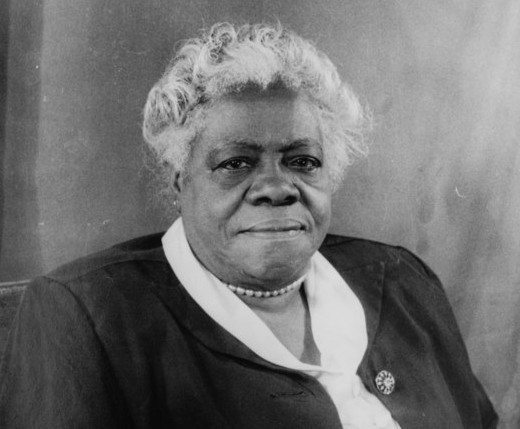
2 notes
·
View notes
Text
Pioneering Black educator's statue to replace Confederate statue at the Capitol

The statue of Mary McLeod Bethune, a civil rights activist born to former slaves, will represent Florida in the National Statuary Hall Collection, starting in 2022.
Civil rights activist and Bethune-Cookman University founder Mary McLeod Bethune will soon make history again.
She will be the first Black person to represent a state in the National Statuary Hall Collection at the U.S. Capitol in Washington, D.C. The renowned educator’s Florida-commissioned statue will be placed permanently in the Capitol in February 2022, replacing the statue of a confederate general.
Standing at 11 feet tall and weighing in at 6,000 pounds, the statue shows Bethune in a cap and gown to signify her dedication to education. It also features a stack of her own books piled next to her. A smaller bronze version will also be placed in Riverfront Park near Mary McLeod Bethune Boulevard.
The statue was created by Nilda Comas, a decorated sculptor who splits her time between Fort Lauderdale, Florida, and Pietrasanta, Italy. She will be the first Latina sculptor with a piece in the Capitol’s collection, according to NPR.

In 2016, then-Gov. Rick Scott approved a measure to remove the statue of Confederate Gen. Edmund Kirby Smith, who was born in Florida, from the Statuary Hall. The bronze was removed in September and temporarily transported to a Florida museum.
The Florida Department of State’s Division of Arts and Culture reviewed the names of more than 3,000 Floridians to replace that statue, narrowing it down to 130 potential subjects. It chose Bethune after receiving 1,233 votes in favor of her to represent the state, according to Evolve Magazine, a business publication based in Florida. The statue was temporarily on display at the Daytona State College’s News-Journal Center until Dec. 12 and will be shipped to Washington.
“Dr. Bethune embodies the very best of the Sunshine State — Floridians and all Americans can take great pride in being represented by the great educator and civil rights icon,” U.S. Rep. Kathy Castor, D-Fla., said in a statement.
Who was Mary McLeod Bethune?
Born in South Carolina in 1875, Bethune was one of 17 children. Her parents were formerly enslaved and the family picked cotton to make a living. Nonetheless, Bethune was committed to her education. She eventually graduated from Scotia Seminary, a Presbyterian boarding school for Black girls, in 1894.
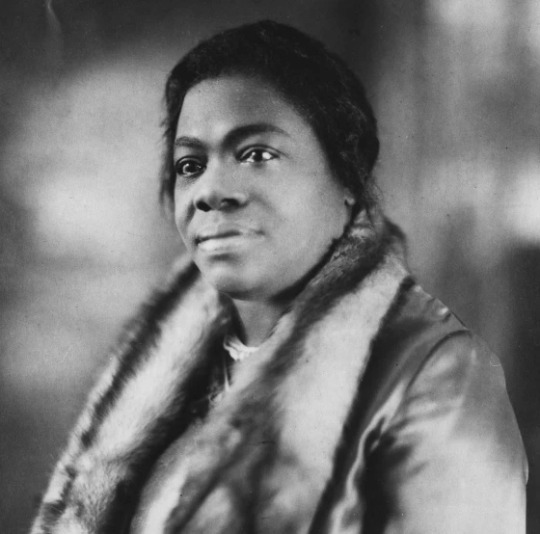
Next, she went north to Chicago to study at the Moody Bible Institute, with the goal of doing missionary work in Africa. At the time, she was the only Black student enrolled. There, she established Sunday schools in neglected parts of Chicago, worked with prisoners in city jails, and helped with the Pacific Garden Mission, which housed and fed hundreds of people each day.
When she sought an opportunity for mission work in Africa, the Presbyterian Board of Missions denied her request and instead sent her to Georgia, where she worked at a school for Black girls. Soon after, she married Albert Bethune, and eventually the couple and their child moved to Florida. While teaching in Palatka, Florida, she learned of the poor living and educational conditions of Black residents of Daytona Beach.
Soon, Bethune started a school in Daytona with a commitment to provide Black girls a higher quality education.
5 notes
·
View notes
Text
1 note
·
View note
Link
LETTERS FROM AN AMERICAN
June 30, 2021
Heather Cox Richardson
Yesterday, by a vote of 285 to 120, the House of Representatives voted to remove the statues of Confederates from the U.S. Capitol. While 67 Republicans voted in favor of the measure, 120 did not. Representative Mo Brooks (R-AL), who told the insurrectionists on January 6 before they stormed the Capitol “"Today is the day American patriots start taking down names and kicking ass," issued a statement titled: “CONGRESSMAN MO BROOKS DEFENDS STATES' RIGHTS, RIPS INTOLERANT SOCIALISTS WHO SEEK TO TAKE DOWN CAPITOL STATUES THEY DON'T LIKE.”
"I support federalism and a state's right to decide for itself who it should honor. As such, I will proudly vote 'No' on H.R. 3005. Alabama, not New Yorkers, Californians, or anyone else, should decide who we wish to honor in Alabama's contribution to the National Statuary Collection," the statement read. “Socialist Democrat states should butt out!”
When voters elected President Joe Biden and gave the Democrats a majority in the House of Representatives and the Senate, Republicans turned to the states they control to enforce their vision of the country.
They began by challenging the elections in those states, challenges that continue in Arizona with an “audit” of the ballots cast in Maricopa County in the 2020 election performed by a company called Cyber Ninjas, whose CEO has recently appeared in a video advancing conspiracies about the election. They have passed laws limiting reproductive rights and the rights of transgender children, and lately they have attacked what they claim is Critical Race Theory being taught in public schools in an attempt to enforce their own version of history.
Now, as Republican governors appear to have settled on using migrants at the border as an issue to undermine President Biden, they have begun to use state power over the National Guard to enforce that attempt.
On June 10, Texas governor Greg Abbott and Arizona governor Doug Ducey invoked the Emergency Management Assistance Compact, an agreement that lets states send aid to each other after a governor has declared a disaster or an emergency. Abbott has declared a disaster and Ducey an emergency over the influx of migrants to the U.S.-Mexico border, saying that the Biden administration is “unwilling or unable” to secure the border.
In fact, since last October, more than a million migrants trying to cross the border have been arrested. Right now, the number of migrants approaching the border is at a two-decade high, with U.S. Customs and Border Protection encountering 180,000 migrants last month. But a high percentage of those apprehended have tried to come multiple times—38% of those apprehended in May—and, operating under a coronavirus protocol established by the Centers for Disease Control and Prevention, Border Protection in May expelled more than 112,000 of those 180,000 migrants. The number of unaccompanied children coming across the border dropped from almost 14,000 in April to about 10,700 in May. Secretary of Homeland Security Alejandro Mayorkas insists that, having inherited a system gutted by the previous administration, Biden’s team has rebuilt the necessary structures to manage migrants at the border.
Nonetheless, Abbott and Ducey have called for governors of other states to send “additional law enforcement personnel and equipment” to “arrest migrants who illegally cross the border into our territory.” The letter concludes: “Texas and Arizona have stepped up to secure the border in the federal government’s absence, and now the Emergency Management Assistance Compact gives your State a chance to stand strong with us.”
Iowa governor Kim Reynolds, Nebraska governor Pete Ricketts, and Florida governor Ron DeSantis have all pledged to send law enforcement to Texas and Arizona. Yesterday, South Dakota governor Kristi Noem one-upped them by announcing that she is sending 50 South Dakota National Guard troops to the U.S.-Mexico border, and that billionaires Willis and Reba Johnson from Franklin, Tennessee, are paying for the troops. Johnson told Josh Kovensky at Talking Points Memo that he was making the donation because “this President would rather help other countries than help America.”
At least some of the Republican focus on taking command of states appears to be backfiring. Voters in Arizona, for example, appear to be turning against those who supported the “audit.” They oppose it by 49-46 percent, and Independents, on whose votes carrying the state depends, oppose the audit by 18 points.
“As bloody red meat for the MAGA Republican base, the audit is manna from heaven, but the problem is that Arizona is not a red state any more. It’s a swing state,” Fernand Amandi, who conducted the survey for Bendixen & Amandi International, told Politico’s Marc Caputo.
But, of course, the other piece of Republican focus on the states has been the dramatic reworking of state election laws to help the Republicans retain control of their state governments no matter what the voters choose.
Still, the federal government is not giving the Trump Republicans a free pass. This afternoon, by a vote of 222 to 190, the House of Representatives voted to create a select committee to investigate the events of January 6. Republicans Liz Cheney of Wyoming and Adam Kinzinger of Illinois were the only two Republicans who voted in favor.
"Our bipartisan, good-faith proposal was met with a filibuster. Now that Senate Republicans have chosen to block the formation of an independent commission, it falls to the House to stay the course and get the answers they deserve," said House Homeland Security Chairman Bennie Thompson (D-MS).
The need for an official investigation was illustrated this evening by the release of a 40-minute investigative video by the New York Times. Using video shot by the rioters themselves, the Times’s Visual Investigations team concluded that there was “a clear feedback loop between President Trump and his supporters.” It showed how close the rioters came to doing far more damage than they did.
—-
Notes:
https://www.politico.com/news/2021/06/29/arizona-ballot-audit-gop-biden-496908
https://clerk.house.gov/Votes/2021196
https://gov.texas.gov/uploads/files/press/Abbott-Ducey_Compact_Letter_to_Governors.pdf
https://www.npr.org/2021/06/29/1011303611/the-house-votes-to-remove-confederate-statues-in-the-u-s-capitol
https://www.bbc.com/news/world-us-canada-57422618
https://www.politico.com/news/2021/06/30/republicans-immigration-political-weapon-497227
https://www.argusleader.com/story/news/2021/06/28/kristi-noem-governor-gov-south-dakota-deploy-national-guard-troops-texas-us-mexico-border/7787945002/
https://www.axios.com/kristi-noem-south-dakota-texas-national-guard-7f679fa9-5312-4185-b614-198ebbc0feaf.html
https://talkingpointsmemo.com/news/leader-of-az-audit-appears-in-conspiracy-theory-doc-alleging-rigged-2020-election
https://talkingpointsmemo.com/news/auto-scrap-billionaire-who-paid-to-send-national-guard-to-southern-border-sounds-off-on-why-he-did-it
https://www.cnn.com/2021/06/29/politics/immigration-migrants-us-mexico-border/index.html
https://www.nytimes.com/2021/06/30/us/jan-6-capitol-attack-takeaways.html
LETTERS FROM AN AMERICAN
HEATHER COX RICHARDSON
#political#Heather Cox Richardson#Letters From An American#corrupt GOP#criminal GoP#January 6 2021#Capitol Insurrection#Confederacy#civil war#voter suppression#racism
7 notes
·
View notes
Text
If you think about it, the United States has allowed for the normalization of the symbols of white nationalism (i.e., the Confederacy) throughout our culture to the point that the current president is arguing that these symbols represent the United States itself
Trump’s recent tweets in opposition to renaming military bases that carry the names of Confederate officers was appalling on many levels. After all, those names symbolize the Confederacy, which was an attempt at the creation of a white nationalist state. That Trump and many other Americans consider such symbols of the Confederacy to be a “part of” our “Great American Heritage” is more than unsettling.
To show more fully how disturbing this is, I’m going to use an analogy. After WWII the symbols of the Nazi state were banned in Germany. But let’s pretend the Germans hadn’t done so.
Can you imagine decades after WWII if the “Sons of Nazis” were still proudly marching down German streets at local parades carrying Nazi swastika flags?
Yet even in recent times in the U.S. the Sons of Confederate Veterans have proudly marched in parades in many parts of the South (although that appears to be changing).
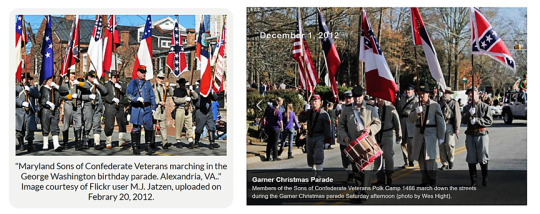
* * *
Can you imagine German entrepreneurs in the 21st century selling lots of T-shirts and clothing items with the Nazi swastika flag on them?
And yet, to this day, 155 years after the Civil War, entrepreneurs in the U.S. sell lots of T-shirts and clothing items with Confederate flags on them.
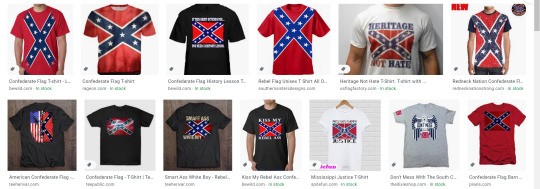
* * *
Imagine if decades after WWII the statues of Nazi politicians and military officers were still prominently displayed in German government halls and squares--including the capital in Berlin? Wouldn’t that suggest that those Nazis were still venerated by Germans?
And yet throughout the United States, there are numerous statues and memorials dedicated to the Confederacy. Perhaps most egregiously, there are 9 statues of Confederate politicians/judges and military officers that are part of the National Statuary Hall Collection in Washington, DC. Fortunately, two of these statues are going to be replaced (Uriah Milton Rose and Edmund Kirby Smith) but at this point seven will remain, including Jefferson Davis and Robert E. Lee.
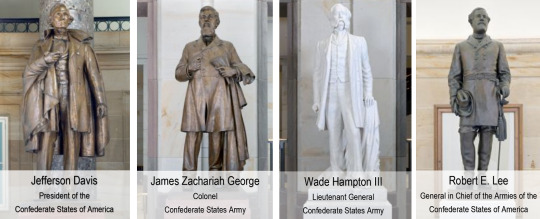

Adding to the problem in the United States is the fact that the numerous monuments to the Confederacy are continuing to be paid for by American taxpayers. For instance, a December 2018 article in Smithsonian claimed that:
“Confederate monuments aren’t just heirlooms, the artifacts of a bygone era. Instead, American taxpayers are still heavily investing in these tributes today. We have found that, over the past ten years, taxpayers have directed at least $40 million to Confederate monuments—statues, homes, parks, museums, libraries and cemeteries—and to Confederate heritage organizations.”
[See more under the cut.]
Can you imagine if for decades after WWII a Nazi swastika flag was proudly displayed at one of Germany’s statehouses and that only recently was this flag taken down? And what if one of its states still had the swastika as an integral symbol on its state flag? Wouldn’t the rest of the world be questioning the values of those German states?
Yet here in the U.S. up until recently the Confederate flag had flown on top of or near the South Carolina Statehouse. Furthermore, the Confederate flag’s design has continued to be an integral part of the state flag of Mississippi. (although a bipartisan group of legislators is trying to change that).
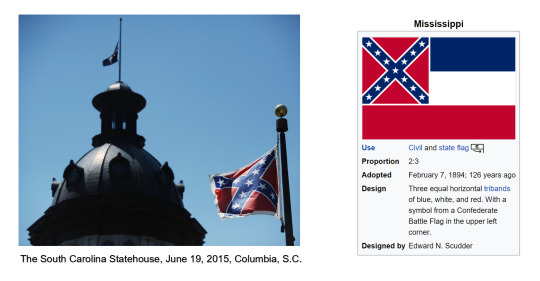
* * *
Can you imagine that up until last week, Nazi swastika flags were flying at race car events in Germany? What sort of message would that send to the world about German enthusiasts of that sport?
And yet until this past week, Confederate flags flew at NASCAR events. (Sadly, there has been considerable push back towards the ban since it was announced.)
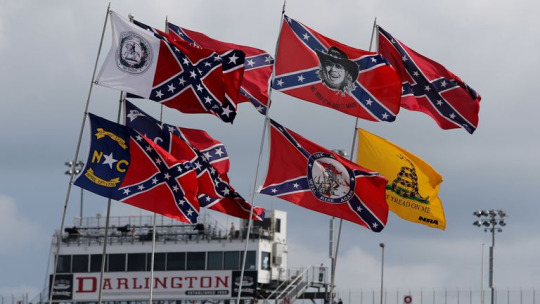
* * *
I could go on and on with this analogy. There are schools and roads named for Confederate politicians and military officers, not to mention the military bases named for Confederate officers that Trump refuses to rename:

By keeping all of this Confederate symbolism in place for 155 years since the Civil War ended, what sort of a message does our nation send to the world about our values?
What messages are being sent to African Americans and other American POC regarding our society’s values?
It is frightening to me that all of this has been so normalized in our culture that there are many Americans (including the current president) who are very upset that anyone wants to get rid of the Confederate symbols that are still plentiful in our nation.
[edited]
#confederate symbols#united states#trump#black lives matter#military bases#values#confederate statues and flags#racism
111 notes
·
View notes